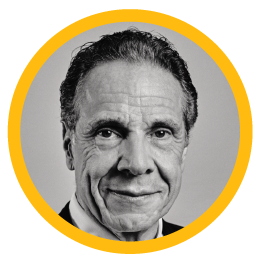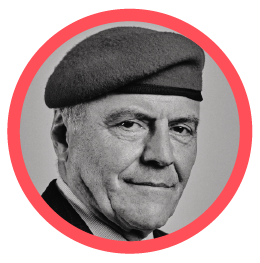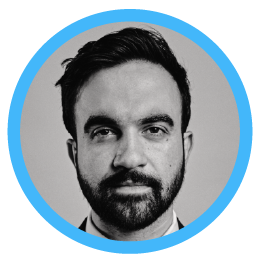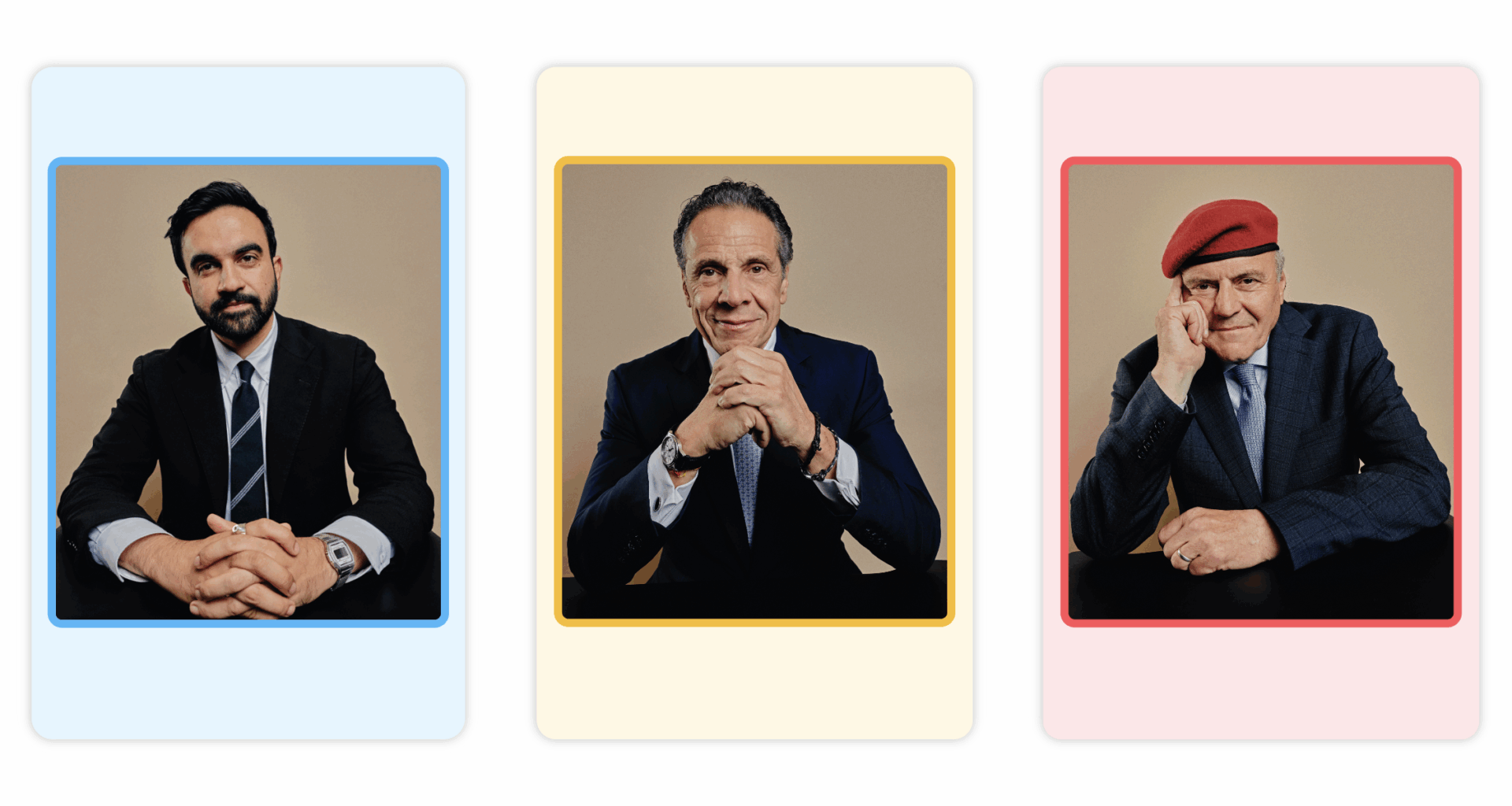By Jennah HaqueElena MejíaLaura Nahmias Video by Rafael Garcia Photography by David Cabrera for Bloomberg October 24, 2025
The contest for who will lead New York City come Jan. 1 has become one of the most closely watched races in the US — a possible bellwether for the future of the Democratic party on issues of affordability, Israel and how best to handle President Donald Trump.
The Nov. 4 election offers voters stark choices — between youthful energy and experience, and between the far left and centrism.
The Democratic nominee, 34-year-old State Assembly Member Zohran Mamdani, is a self-described democratic socialist who would be the city’s youngest mayor in a century and the first South Asian and Muslim mayor in the city’s 400-year history.
Mamdani’s closest rival in the race is former Governor Andrew Cuomo. Like his father, Mario, Cuomo was elected to lead the Empire State three times. He resigned in 2021 amid allegations of sexual harassment, which he denies. After his loss to Mamdani in the Democratic primary, which shocked the city’s establishment, Cuomo is running as an independent.
For the first time in decades, the incumbent mayor, Eric Adams, isn’t running for reelection. He exited the race Sept. 28, after years of corruption allegations critically damaged his ability to fundraise and campaign. Republican candidate Curtis Sliwa, founder of the Guardian Angels, is picking up as much as a quarter of the vote in a city where Democrats outnumber Republicans 6 to 1.
The Candidates
Early voting begins Oct. 25. Bloomberg News invited all the mayoral candidates for roundtable discussions consisting of open-ended and multiple-choice questions on nearly two dozen topics. Here’s where the candidates stand on a number of key issues impacting New Yorkers.
Housing Number of Affordable Housing Units Started
Source: New York City Open Data
Note: Data through June 30, 2025. It includes new construction and rehabilitation projects.
Between some of the lowest vacancy rates in nearly 60 years and record-high median rents, the high cost of housing and an affordability crisis has become the dominant issue in this mayoral race.
Housing experts, residents and politicans alike all agree the city is in dire need of more housing. One report estimates the city needs over half a million new units by 2030 to meet demand. However, space comes at a premium, and ambitions to convert office spaces into residential units can be costly. All the candidates said they see housing as a pressing issue.
How do you consider when to prioritize public spaces, and when to prioritize development?
What do you think is the best strategy for building more affordable housing?
Sliwa “I am opposed to the City of Yes.” Sliwa said he wants to enforce zoning restrictions more and get vacant apartments back on the market.
Will you support new or existing real estate tax incentives like 485-x and 467-m, which are designed to protect smaller rental projects and promote office conversion residential developments? Rent Increases for Rent-Stabilized Apartments
Source: Rent Guidelines Board
Note: Rates are for one year starting on or after Oct. 1.
The mayor cannot set a rent freeze for the city’s 1 million rent-stabilized dwellings. That’s decided by the Rent Guidelines Board, whose nine members are appointed by the mayor. The governing body is mandated to set rent increases based on annual housing supply, vacancy levels and insurance costs data, as well as testimonials. A multi-year rent freeze could face legal challenges.
During former Mayor Bill de Blasio’s administration, city officials froze rents at regulated properties four times. But under Adams, rent increases were approved every year.
Proponents say rent freezes can provide a moment of relief for tenants already struggling to make rent at a time when landlords’ net operating income outpaces inflation. Critics say a rent freeze would cut landlord profits, deter building maintenance and slow housing development.
Read more: Adams Weighs Stacking Rent Board, Risking Mamdani Priority
Would you institute a rent freeze on stabilized apartments? If so, for how long?
No


Yes, for 1–2 years
No candidates
Yes, for more than two years

Mamdani “I’ve committed to freezing the rent for the more than 2 million New Yorkers who live in rent-stabilized housing for four years.”
The New York City Housing Authority provides public housing to more than half a million low and moderate income New Yorkers. NYCHA has long faced funding gaps, low rent collection rates and poor housing conditions for tenants.
Do you support changes to funding for NYCHA affordable housing?
Yes, through public-private partnerships to provide more funding

Yes, through a pied-a-terre tax or other taxes on luxury development

Yes, through some other model


Mamdani has said he wants to add $70 billion through municipal bonds to support housing efforts.
Sliwa said he wants to offer a pathway for ownership in NYCHA communities.
Crime and Homelessness Crime and Offense Incidents
Source: New York Police Department
Note: Major felonies include murder and manslaughter, rape, robbery, felony assault, burglary, grand larceny and grand larceny of a motor vehicle.
Murder and other major felonies have declined from their 17-year high in 2023. Year-to-date, New York has experienced the lowest levels of shooting incidents and victims in recorded history. But misdemeanors have continually trended upwards since the pandemic. That’s contributed to a perception of disorder in the nation’s biggest city.
Hate crimes are down 26% in 2025 after a steady four year rise, according to the New York Police Department. In that period, Jewish individuals were disproportionately targeted. Each candidate has made addressing hate crimes a centerpiece of their campaigns.
How will you address hate crimes in the city?
The NYPD employs around 34,000 uniformed officers, just short of the budgeted headcount of 35,000. The department is facing some of its lowest headcounts relative to the population in decades. The NYPD regularly exceeds its annual budget due to overtime costs that the City Council has described as “potential corruption.”
How many uniformed police officers should the NYPD have?
Less headcount than currently staffed or budgeted
No candidates
The current or budgeted headcount is sufficient

More headcount than currently staffed or budgeted


Cuomo “I say hire 5,000.”
Sliwa “We need at least an additional 7,000 officers.” Sliwa said he wants to bring back qualified immunity.
Two state-level policies introduced this year aim to reduce the city’s perceived disorder. Concerns over the actions of masked protestors prompted state legislators to propose a law increasing penalties for masked individuals accused of menacing or threatening others. The proposed legislation remains in committee.
Do you support the proposed law on penalizing masked individuals?
Feel the proposed law goes too far


Support the law as written
No candidates
Feel the proposed law doesn’t go far enough

Mamdani “They discriminate against those who are at increased risk from COVID, eat away at our civil liberties, and open the possibility for unequal enforcement of the law.”
Cuomo “I get the concept of the law. I think it’s problematic in its implementation and its constitutionality.”
Sliwa said he supports the Nassau County law which bans all masks with the exception of medical and religious uses.
New York’s Mental Hygeine Law states that if a seriously mentally ill person poses a threat to themselves or others and meets other criteria, it is legal for physicians to involuntarily commit that person to a health facility to receive treatment. This year, New York Governor Kathy Hochul extended involuntary commitment powers to first responders. All the candidates said involuntary commitment is a necessary tool in ending homelessness and improving public safety.
Do you support involuntary commitment?
Mamdani “I think it should be utilized as a last resort.”
Migrants
Source: Office of New York City Mayor
Note: Data through Oct. 19, 2025.
New York is a so-called sanctuary city, meaning local officials are restricted in how much they can support federal agenices like Immigration and Customs Enforcement. The US Justice Department sued the city over its sanctuary policies in July.
Would you advocate for changes to New York City’s sanctuary city status?
Yes, by cooperating more with federal agencies
No candidates
Yes, by cooperating less with federal agencies

No changes to the city’s current sanctuary city status

Something else

Mamdani suggested the city should offer more legal representation for deportation proceedings than it currently is.
Sliwa “It should be put to a vote of the people. I would follow the will of the people.”
Economy and Taxes Key Line Items in NYC FY2026 Budget
Source: New York City Office of Management and Budget
New York City’s economy is strong — it draws tax revenue from multiple sources, its debt service ratio is considered reasonable, and it has a comfortable cash reserve in the case of an emergency. The annual budget is massive, reaching $116 billion for fiscal year 2026. That’s more than eight times the the annual budget of the city of Los Angeles.
Property taxes account for 44% of the city’s tax revenue, while 25% comes from income taxes. The city is one of a few in the country that levies its own income tax, in addition to state income tax. Any new taxes or changes to existing taxes, excluding the city’s property levies, must be approved by the state legislature and the governor. Hochul has said she will not approve city requests for new taxes.
Will you need tax increases from Albany to pay for your agenda?
Mamdani has called for raising the highest state corporate tax rate to match New Jersey’s and a flat 2% city tax increase on income over $1 million.
Cuomo “You are going to have to find the money.” Cuomo said tax increases from Albany would be irresponsible.
Sliwa said he can pay for his agenda through budget cuts for the Department of Education and doing away with the Department of Buildings.
Critics have long decried the city’s property tax system, which effectively taxes renters, who tend to be less wealthy and less white, at higher rates than homeowners. Property tax revenue makes up such a significant part of the city’s budget that no mayor in recent history has even attempted to reform it, despite pledges to do so. Unless city officials agree to reforms that might yield less revenue for the city overall, any reform that lowers rates for renters would mean raising rates on other types of property owners.
Should New York’s property tax system be reformed?
No, it’s fine the way it is
No candidates
Yes, but it should be revenue neutral

Yes, even if the system brings in less revenue


Mamdani “It has to be reformed with the view to it actually being a fair system.”
Cuomo “I don’t think you have that luxury where you’re going to be able to do it with less revenue depending on what happens with the economy.”
Sliwa “Particularly for homeowners, there needs to be a slash in the property taxes.”
How will you support the business community in New York?
Mamdani said he wants to cut fines and fees for small business by 50% and increase funding for business express service teams.
Cuomo “You have to custom design the package for a specific business.”
Sliwa said he wants to establish better communication lines between government agencies and businesses.
Transit MTA Annual Ridership
Sources: New York State Open Data, MTA
Note: 2020 data does not include the first two months of the year.
Congestion pricing has been an overwhelming success, on track to bring in $500 million in revenue this year and traffic is down nearly 25% in the relief zone. Cuomo signed a state bill authorizing the program into law in 2019 but criticized the program’s rollout.
NYC subway ridership still hovers around 70% of pre-pandemic levels, and bus ridership stands at about 60%. The candidates all agreed that more can be done to bring riders back.
Do you support or oppose congestion pricing in Manhattan?
Sliwa said the toll is affecting foot traffic at small retail businesses and spurring some of the cost-of-living squeeze.
What, if anything, do you think would be most effective at increasing MTA ridership?
Cleaner and/or more accessible stations


More law enforcement officers in stations and on trains

Those riders are fundamentally gone, and the target needs to change
No candidates
Cuomo “It’s accessibility, safety, cleanliness, reliability. But safety is number one.”
Sliwa “It is a humiliating circumstance to stand on a subway platform and just to suffocate from the smells that emerge.”
Childcare and Education
Childcare affordability continues to burden parents across income brackets and neighborhoods.
Full-Time Nanny Average Weekly Rate
Source: Care.com
Note: Data through Oct. 1, 2025.
Former mayor Bill de Blasio made full-day Pre-K universally free for all 4-year-olds. The city also offers free six-hour schooling for 3-year-olds, though children aren’t guaranteed a seat in their neighborhood. Adams signficantly reduced funding for 3-K expansion during his tenure. Neighborhoods with low-performing schools tend to have empty seats, while places with high-performing schools have long waitlists, forcing parents to resort of private options.
Those aren’t cheap. According to Care.com, the cost of hiring a full-time nanny has increased 44% since right before the pandemic began. The sticker price has surpassed $1,000 per week.
What would you prioritize first to address childcare affordability?
Universal after-school care


Ensuring 3-K is truly universal
Expanding 3-K to 2-K
No candidates
Family tax credit
No candidates
Mamdani has said he wants to provide childcare for all children from 6 weeks to 5 years of age. He said he would first tackle 3-K.
Cuomo said he would first tackle 3-K and then after-school care.
NYC Public Schools K-12
Enrollment
Source: New York State Education Department
Note: Data reported by academic year.
Education is the biggest expense in the city’s budget, with more than $35 billion going to the Department of Education this fiscal year.
NYC public schools are facing dropping enrollment as many families opt for private schooling or leave the city altogether. Some parents and educators alike see lottery-based charter schools as the solution for better outcomes, but critics claim they divert resources from public schools. New York City has reached its cap of 50 charter schools and the mayor would need to advocate to Albany to raise it.
Which would you prioritize first to improve student educational outcomes?
Increase cap and resources to charter schools


Relinquish mayoral control of school systems
No candidates
Remove remote learning options
No candidates
Expand and create tutoring programs


Something else

Mamdani said he would first focus on adhering to the Class Size Reduction Plan. He said he remains skeptical of mayoral control of the Department of Education.
The city’s nine specialized high schools are considered by many to be the crown jewel of the school system. Eighth- and ninth-graders take a standardized test to gain admittance into eight of the schools. More than 25,000 students sat for the test last year. Just over 4,000 students earned a spot. The ninth specialized school admits students based on auditions. Mamdani attended one of the specialized high schools: the Bronx School of Science.
Would you make any changes to the high school admissions process?
Sliwa said he would add more specialized schools that emphasized vocational training.
Trump
At the start of the federal government shutdown in October, President Donald Trump froze $18 billion in infrastructure funds over DEI concerns. About $187 million in counterterrorism cuts have been restored. The administration has already attempted to dismantle the city’s congestion pricing program, and Trump has vowed to withold further federal funds if Mamdani is elected.
To protect New York City from further attacks, all three candidates said that preserving a working relationship with the president would be critical.
Are there areas of city funding you’d be willing to compromise on to make a deal with Trump?
If President Trump were to cut federal funding for NYC, how would you first attempt to restore funding?
Cuomo “You have to get there before and establish paramters before he acts. After he acts, it’s too late.”
Israel and Gaza
New York is home to the largest Jewish population outside of Israel and the largest Muslim population in the US. In the wake of the Israel-Hamas war, some New Yorkers have begun to question the city’s institutional links with the Jewish state, while others want the city to strengthen its ties and do more to combat antisemitism.
The city has long-standing partnerships with Israel. Adams has further bolstered the relationship through the NYC-Israel Economic Council, which helps Israeli companies expand into New York City. The NYPD has its own liaison in Israel, engages in police exchange programs and shares intelligence as part of the city’s counterterrorism efforts. Cornell University is partnering with Technion-Israel Institute of Technology to open and operate a graduate research and technology campus on Roosevelt Island. The city’s pension funds no longer holds any Israeli bonds but still holds $291 million worth of investments in Israeli companies.
Would you make changes to any of New York City’s existing institutional partnerships with Israel or Israeli companies?
Mamdani “I would cease the Israel Economic Council that the mayor stepped up.” Mamdani also said he supports the current comptroller’s approach to not purchase new Israeli bonds.
Cuomo “I don’t know the extent of the contracts we have, so none that I know of.”
In June, Adams signed an executive order which adopted the International Holocaust Remembrance Alliance’s working definition of antisemitism as the guidelines for city agencies to use in addressing incidents of anti-Jewish hate.
Which position most closely represents your view of the IHRA?
The IHRA goes too far in its definition of antisemitism

The definition in the IHRA is appropriate

The IHRA should go further in defining antisemitism
No candidates
Something else

Mamdani “I believe that the IHRA is a definition that conflates antisemitism with anti-Zionism. And there are a number of leading Jewish institutions, including the author of the original definition of the IHRA that have real concerns about the application of that definition.”
Sliwa “I support the vast majority of the IHRA’s antisemitism definition […] Particular aspects of their proposed definition’s examples of antisemitism, such as labeling speech regarding Jewish citizens’ loyalty to Israel as antisemetic, I believe, go too far in their scope and provide concerns regarding free speech, if it were to be legally adopted and implemented.”
Pro-Palestinian demonstrations on the city’s college campuses have prompted, in some cases, strict crackdowns. In March, former Columbia graduate student Mahmoud Khalil was detained by ICE and sent to a detention center in Louisiana for his Palestinian activism on campus. The detention sparked outcry over free speech protection and was later ruled unconstitutional by a federal judge.
Should foreign-born students face deportation for engaging in pro-Palestinian protests? With assistance from Rachael DottleJeremy Scott DiamondDenise Lu Edited by Kate RabinowitzChloe WhiteakerMark SchoifetKatia Porzecanski Photo editor Marie Monteleone

